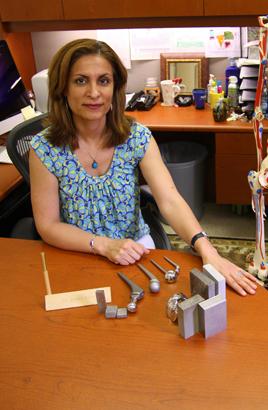Researchers at N.C. State developed a new high strength metal foam that could save energy and lives due to its extraordinarily high energy absorption capability and light weight.
The metal foam can reduce or eliminate injuries from collisions, while reducing mass without sacrificing strength and impact protection as a result.
It can also absorb 70-80 times more energy than steel, and it’s much lighter. The foam is estimated to offer over 80 times greater energy abortion than the bulk material from which the foam is made, according to Afsaneh Rabiei, an associate professor of mechanical and aerospace engineering and an associate faculty member of biomedical engineering at the University.
To illustrate the foam’s high-energy absorption ability, Rabiei said that if a simple four-passenger car uses the new material behind the bumper and had an accident going 28 miles per hour, it would feel as if it was an accident happening at five miles per hour to the passengers inside.
In addition, the “modulus of elasticity” of the foam is very similar to that of bone. Modulus of elasticity, which is measured in gigapascals (GPa), measures a material’s ability to deform when pressure is applied and then return to its original shape when pressure is removed. The foam can compress up to 80 percent of its original size under loading and still retain its original shape.
“The modulus of elasticity of a bone is something around 10-30 GPa and depending on age of the patient, the density of the bone,” Rabiei said. “For years and years, scientists were trying to find materials with lower modulus of elasticity to match the modulus of elasticity of bone.”
According to Rabiei, if the modulus of elasticity of an implant in a bone is too much bigger than the bone, the implant will take over the load bearing, and the surrounding bone will start to die, which will cause the loosening of the implant and eventually failure of the implant – known as stress shielding.
When this happens, the patient will need to undergo another surgery to replace the implant. This composite foam prevents stress shielding from occurring.
Experiments showed an elastic modulus of 10–12 GPa for aluminum–steel composite foams
“Originally, the implants were made of steel. Then people starting using titanium because steel has modulus of elasticity around 200 GPa and titanium has a modulus of elasticity around 100,” Rabiei said. “But it is still not ideal because it’s over three times higher than the most dense bone.”
In addition to having a modulus of elasticity closer to that of bone, the rough surface of the foam would also stimulate bone growth into the implant, improving the strength of the implant. The implant will bond well with the new bone formed around it and let the body build inside its surface porosities.
This will increase the mechanical stability and strength of the implant inside the body. Rabiei said her team did not have biomedical applications in mind when they started the research.
“It’s something that we did not expect to happen. We were not thinking about biomedical applications,” Rabiei said.
“Although our mission was to find light materials, mostly for structural applications, when we studied the modulus of elasticity of this material, we discovered that this was the closest possible modulus elasticity to bone, so it would be revolutionary if we used it for implants,” Rabiei said.
According to Rabiei, the goal was to make something that can save energy, save money and save lives.
“But down the road, we figured out that the properties are great for biomedical applications,” she said.
The foam could mean a new generation of biomedical implants.
Rabiei said there are endless possibilities for her metal foam, including airplanes, boats and structures that need impact protection while maintaining low weight.
Additional research is still being done with the metal foam.
“We are now looking into the high speed impact properties,” Rabiei said.
The research, “Evaluation of modulus of elasticity of composite metal foams by experimental and numerical techniques,” was funded by the National Science Foundation and is published in the March issue of Materials Science and Engineering A.








